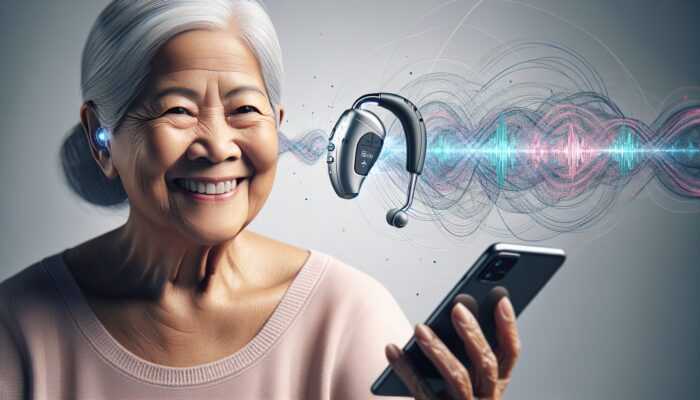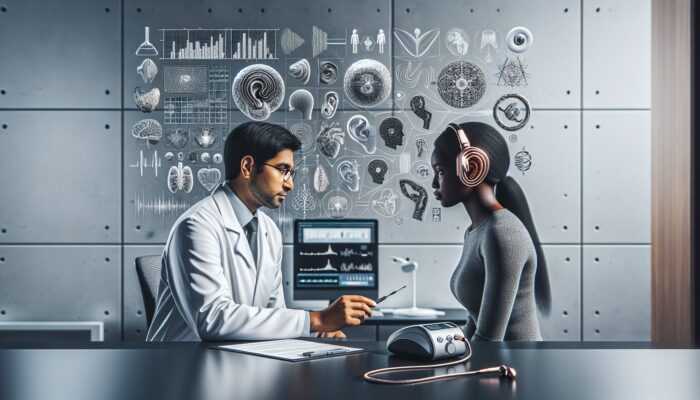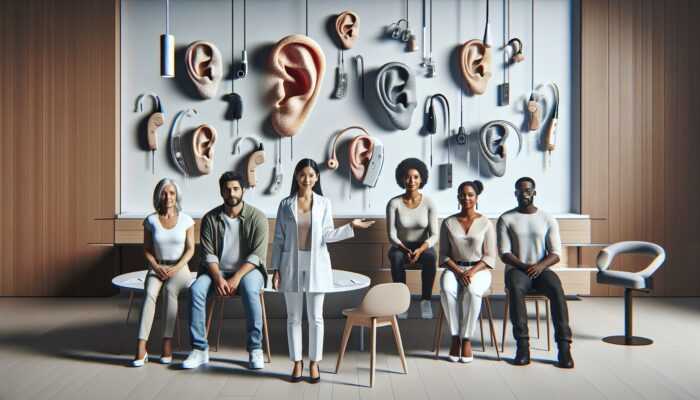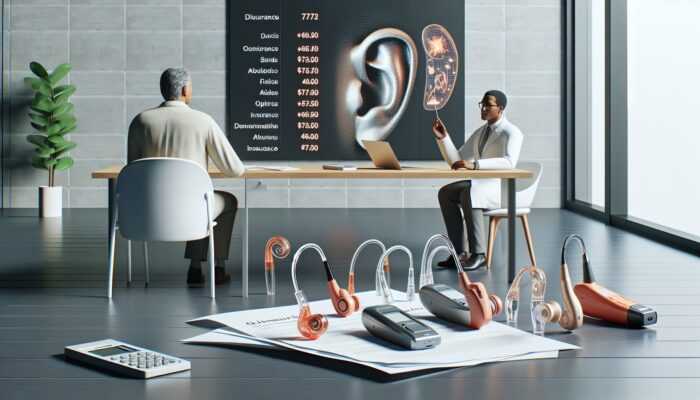Explore the Innovations in Hearing Aid Technology
What Are Hearing Aids and How Do They Function?

Hearing aids are cutting-edge electronic devices designed specifically to improve hearing for individuals suffering from hearing loss. These remarkable devices function by amplifying sound waves to levels that the user can easily perceive, effectively bridging the gap between the rich sounds of the environment and the user’s auditory experience. Each hearing aid is carefully customized to address the individual’s specific hearing loss profile, ensuring both optimal functionality and comfort. The essential components of a hearing aid generally include:
- Microphone
- Amplifier
- Speaker
- Battery
- Receiver
- Digital Signal Processor (DSP)
- Bluetooth Connectivity
- Directional Microphones
These integral components operate collaboratively to enhance the auditory experience, showcasing the remarkable advancements in both audiology and technology over the years. The transition from basic amplifiers to sophisticated hearing aids illustrates a significant leap in innovation, making these devices more effective and user-friendly than ever before.
How Do Hearing Aids Function Effectively?
Hearing aids utilize a systematic approach to enhance sound perception, beginning with sound capture through a built-in microphone. Once sound waves are collected, they undergo a complex series of processes where they are meticulously analyzed and tailored to amplify specific frequencies that correlate with the user’s unique hearing loss characteristics. The enhanced sound is subsequently transmitted to the ear through a high-quality speaker.
The technology employed in modern hearing aids allows for real-time adjustments based on varying environments, adapting seamlessly to different settings, whether in tranquil rooms or vibrant social gatherings. This adaptability guarantees that users can enjoy a personalized listening experience, whether they are immersed in the silence of a library or the bustling atmosphere of a café. With continuous technological advancements, many contemporary hearing aids are equipped with integrated sensors that automatically switch between multiple sound processing modes, significantly enhancing their versatility.
Key Components Driving Modern Hearing Aids
Modern hearing aids represent a harmonious fusion of advanced technology and user-centric design, featuring several critical components that collectively enhance auditory capabilities. At the heart of every hearing aid lies the microphone, which captures sound waves from the surrounding environment. Another pivotal component is the digital signal processor (DSP), which plays a crucial role in analyzing these sound waves, applying necessary enhancements, and converting them into digital signals for improved clarity.
The amplifier then boosts the strength of these signals before they reach the speaker, which finally delivers the sound directly to the ear. Recent innovations have also introduced features like feedback cancellation systems, preventing annoying whistling sounds, and directional microphones that prioritize specific sound sources while minimizing background noise. This seamless synergy of components is what empowers modern hearing aids to provide clear, high-quality sound tailored to the unique needs of each user.
What Are the Latest Breakthroughs in Hearing Aid Technology?

The realm of hearing aid technology is experiencing rapid evolution, leading to an exciting spectrum of advancements that significantly elevate user experience. One of the most remarkable developments is the advent of wireless connectivity, which allows hearing aids to effortlessly connect with smartphones and other devices, fostering seamless communication. This connectivity enables users to stream music, phone calls, and various audio directly to their hearing aids, creating a more integrated and enjoyable auditory experience.
Additionally, the introduction of rechargeable batteries is transforming the convenience of using hearing aids. Users are liberated from the hassle of frequently changing batteries, as many modern models can be charged overnight and sustain functionality throughout the day. Moreover, the integration of artificial intelligence into hearing aids is enabling them to learn and adapt to user preferences and environmental conditions over time. This incorporation of AI enhances both sound quality and user satisfaction, providing a truly personalized listening experience.
Expert Perspectives on the Evolution of Hearing Aid Technology
How Have Hearing Aids Transformed Over Time?
Hearing aids have undergone a remarkable transformation, evolving from basic analog devices to sophisticated digital systems that leverage contemporary technology to deliver exceptional sound quality. Historically, analog hearing aids primarily functioned to amplify sounds uniformly, offering minimal customization options for varying degrees of hearing loss. In contrast, today’s digital hearing aids utilize advanced algorithms to analyze sound environments in real time, enabling features such as noise reduction, directional microphones, and feedback suppression.
This evolution has not only enhanced the functionality of hearing aids but has also significantly improved the overall user experience. Looking ahead, the trajectory suggests a growing emphasis on integrating smart technology and designing user-centric devices. Anticipated innovations will likely focus on improving battery life, refining compact designs, and expanding connectivity options, ultimately making hearing aids more accessible and effective for users worldwide.
What Are the Most Recent Innovations in Hearing Aid Technology?

Recent innovations in hearing aid technology have profoundly transformed the auditory assistance landscape, enhancing both functionality and user experience. A standout development is the integration of Bluetooth technology, allowing users to connect their hearing aids to a variety of devices, including smartphones and televisions. This feature simplifies media consumption and communication, eliminating external distractions.
Rechargeable batteries represent another significant advancement, providing unmatched convenience and alleviating the need for frequent battery replacements. Furthermore, the incorporation of artificial intelligence in sound processing empowers hearing aids to automatically adjust settings based on the surrounding listening environment. For instance, in a crowded restaurant, AI can enhance speech clarity while minimizing background noise, delivering a customized auditory experience. Real-world applications of these advancements demonstrate that users experience heightened satisfaction and improved communication abilities, underscoring the positive impact of these technologies.
Understanding the Importance of Digital Signal Processing
Digital signal processing (DSP) is a critical element of modern hearing aids that significantly influences their performance. Through the capabilities of DSP, hearing aids can analyze incoming sound waves in real time, enabling instantaneous adjustments to enhance clarity and minimize background noise. This technology allows for the customization of sound amplification, targeting specific frequencies that correspond to the user’s unique hearing loss profile, ultimately resulting in a clearer and more enjoyable listening experience.
The sophistication of DSP technology facilitates advanced features such as sound classification, which identifies different sound environments—whether in a quiet room or a noisy street—and adjusts amplification settings accordingly. Additionally, DSP plays a vital role in refining music listening experiences by delivering a more balanced sound quality. As digital signal processing continues to advance, we can look forward to even more refined sound manipulation capabilities, contributing to a better quality of life for hearing aid users.
Understanding the Mechanics of Sound Processing in Hearing Aids
What Is Sound Processing in Hearing Aids?
Sound processing in hearing aids is a sophisticated mechanism that involves capturing audio, analyzing it, and modifying it to enhance intelligibility for the user. This technological marvel enables hearing aids to amplify particular frequencies that individuals with hearing loss may find challenging to perceive, ensuring that sounds are not only audible but also clear. The sound processing mechanisms in modern devices are highly customizable, allowing for a tailored auditory experience.
Key sound processing techniques utilized in hearing aids include:
- Adaptive Noise Reduction
- Frequency Shifting
- Dynamic Range Compression
- Multi-channel Processing
- Feedback Management
- Sound Localization
- Real-time Adjustment
- Speech Enhancement
These techniques work in harmony to ensure that users can navigate various auditory environments with ease, significantly enhancing their overall quality of life and interaction with the world around them.
Enhancing Auditory Focus with Directional Microphones and Noise Reduction
Directional microphones are a crucial feature in modern hearing aids, specifically designed to enhance the user’s ability to focus on sounds emanating from a particular direction while reducing background noise. This technology proves immensely beneficial in social scenarios where multiple sounds compete for the listener’s attention. By isolating sounds in front of the user, directional microphones significantly improve speech clarity, making conversations more intelligible and enjoyable.
Alongside directional microphones, advanced noise reduction algorithms further refine the auditory experience. These algorithms analyze the sound environment and suppress unwanted background noise while amplifying speech frequencies, ensuring that users can enjoy clearer communication without distractions often found in noisy settings. The integration of these technologies not only facilitates better hearing but also contributes to emotional well-being, enabling individuals to engage more fully in social interactions and relationships.
What Are Feedback Cancellation Techniques and How Do They Work?
Feedback cancellation is a vital aspect of hearing aid technology that addresses a prevalent issue known as feedback, which presents as an annoying whistling sound when amplified sounds re-enter the microphone. Modern hearing aids utilize advanced feedback cancellation techniques to manage this phenomenon, significantly enhancing the user experience. These techniques deploy sophisticated algorithms that continuously monitor sound levels and adjust amplification accordingly, ensuring that feedback is minimized without compromising sound clarity.
By implementing real-time feedback management systems, hearing aids can deliver a more comfortable listening experience, allowing users to engage in conversations without the anxiety of disruptive sounds. This feature is especially essential in dynamic environments where sound levels fluctuate frequently, showcasing the significant technological advancements achieved in hearing aid design and functionality.
Understanding Frequency Compression and Transposition Techniques
Frequency compression and transposition are specialized sound processing techniques utilized in hearing aids to assist individuals with high-frequency hearing loss. These strategies involve adjusting the pitch of sounds, making them more accessible and understandable for users who struggle to hear higher frequencies. In frequency compression, higher frequency sounds are compressed into a lower frequency range that the user can perceive, ensuring that vital speech cues are not overlooked.
Transposition, conversely, shifts higher frequency sounds down to a more audible range, allowing users to experience a broader spectrum of sounds. Both techniques are instrumental in improving speech intelligibility and enhancing the overall auditory experience for individuals with specific types of hearing loss. By integrating these advanced sound processing features, hearing aids empower users to engage more fully in conversations and social interactions, enriching their quality of life.
Evidence-Based Benefits of Hearing Aid Technology
How Do Hearing Aids Contribute to Quality of Life Improvements?
The integration of hearing aids into the daily lives of individuals with hearing loss has been shown to significantly enhance numerous aspects of quality of life. These devices promote improved communication, enabling users to connect more effectively with family, friends, and colleagues. Enhanced communication leads to increased social interaction, which has profound effects on mental well-being and overall happiness.
Numerous studies indicate that the consistent use of hearing aids can reduce the risk of cognitive decline, particularly among older adults. By ensuring that users remain actively engaged in conversations and social activities, hearing aids contribute to maintaining cognitive health and alleviating feelings of isolation. To maximize these benefits, users are encouraged to actively participate in social settings, engage in community activities, and consult with audiologists for optimal device fitting and adjustment.
The Connection Between Hearing Aids and Cognitive Health
Research has established a compelling link between the use of hearing aids and cognitive health, particularly in older adults. Studies have shown that individuals utilizing hearing aids experience a slower rate of cognitive decline compared to those who do not use them. The cognitive load associated with the struggle to hear can lead to mental fatigue and increased stress, adversely affecting brain function.
By improving auditory input, hearing aids reduce the cognitive effort required to understand speech and sounds, allowing the brain to allocate resources more efficiently. This reduction in cognitive load not only enhances daily functioning but also fosters better mental health. Encouraging individuals to adopt hearing aids early in the hearing loss journey can serve as a proactive measure for maintaining cognitive vitality as they age.
Long-Term Advantages of Using Hearing Aids
The long-term benefits of using hearing aids extend beyond mere auditory enhancement; they significantly impact various facets of a user’s life. Over time, consistent hearing aid use can result in improved speech comprehension, heightened social engagement, and reduced risks of depression and anxiety. Collectively, these benefits enhance the overall quality of life for users, promoting a sense of independence and connection to their surrounding world.
Moreover, studies have revealed that individuals who regularly use hearing aids report higher levels of life satisfaction and emotional well-being. This positive impact is particularly pronounced in social situations where clear communication is essential. As users become more accustomed to their hearing aids, they often experience increased confidence in their ability to interact with others, further reinforcing the social advantages of these devices.
How Do Hearing Aids Foster Emotional Well-being?
The emotional well-being of individuals with hearing loss is deeply influenced by their ability to communicate effectively. Hearing aids play a pivotal role in enhancing this aspect of life by mitigating feelings of isolation and frustration often linked to untreated hearing loss. Users frequently report a boost in confidence and a more positive outlook on life after they begin using hearing aids.
Enhanced communication abilities facilitate deeper connections with friends and family, which are essential for emotional health. As users become more engaged in social interactions, they experience a sense of belonging and support that contributes to overall happiness. Additionally, the empowerment gained from being able to actively participate in conversations fosters a greater sense of self-worth and fulfillment, enriching the emotional landscape of their lives.
The Role of Hearing Aids in Combating Social Isolation
Hearing aids are powerful tools in the fight against social isolation, a common challenge faced by individuals with hearing loss. By improving communication capabilities, hearing aids enable users to maintain connections with their social circles, reducing the risk of loneliness and its associated health issues. Enhanced auditory clarity allows users to engage in conversations effortlessly, leading to more meaningful interactions and relationships.
Social isolation can have detrimental effects on both mental and physical health, making it imperative to address this issue. Hearing aids facilitate access to social activities and community events, encouraging users to actively participate in their surroundings. By fostering connections and alleviating feelings of alienation, hearing aids significantly contribute to the overall well-being of users, highlighting the necessity for early intervention and consistent use of these devices.
What Challenges Exist in the Development of Hearing Aid Technology?
Addressing Unique Hearing Loss Profiles
One of the primary challenges in the development of hearing aid technology is the individuality of hearing loss profiles. Each person’s auditory needs are distinct, influenced by factors such as the type and degree of hearing loss, age, lifestyle, and personal preferences. Consequently, creating hearing aids that cater to this diversity requires innovative technology and a thorough understanding of audiology.
Manufacturers are increasingly focusing on customizable solutions that empower users to tailor their hearing aids to their specific needs. This includes the ability to adjust settings for different environments and activities, ensuring that individuals receive optimal support across various situations. The challenge persists in providing accessible technology that can be easily personalized, bridging the gap between complex audiological needs and user-friendly features.
Balancing Sound Quality with Device Size
The ongoing challenge of balancing sound quality with device size is a significant consideration in hearing aid development. While smaller hearing aids are preferred for their comfort and discreetness, they must not compromise sound quality. Engineers and designers face the intricate task of miniaturizing components without sacrificing performance, which is essential for user satisfaction.
Advancements in technology have facilitated the production of smaller, more efficient components that maintain high sound quality. However, achieving this balance remains a focus of ongoing research and innovation within the industry. By continually exploring new materials and design techniques, manufacturers aim to meet the demand for compact, high-performance hearing aids that cater to the preferences of modern users.
Ensuring Accessibility and Affordability in Hearing Aid Technology
One of the critical challenges facing the hearing aid industry is ensuring that advanced technology remains accessible and affordable for a broad demographic. Many individuals with hearing loss encounter barriers in obtaining necessary devices due to high costs and limited insurance coverage. To address this issue, the industry is exploring innovative manufacturing techniques and materials that can reduce production costs while maintaining quality.
Initiatives aimed at promoting awareness and education about hearing health also play a vital role in increasing accessibility. By advocating for policies that support affordable hearing care and expanding access to audiology services, the industry can help bridge the gap for those in need. Ensuring that hearing aids are both affordable and accessible is crucial for enhancing the quality of life for individuals with hearing loss globally.
Looking Ahead: Future Directions in Hearing Aid Technology
The Transformative Role of Artificial Intelligence
Artificial intelligence (AI) is set to play a transformative role in the future of hearing aid technology. By leveraging machine learning algorithms, hearing aids can adapt to the individual preferences of users, automatically adjusting settings based on their listening environments. This adaptive functionality allows for a more personalized auditory experience, ensuring optimal sound quality across varying situations.
AI-driven features may also include advanced sound classification capabilities, enabling hearing aids to recognize and prioritize specific sounds, such as speech in crowded environments. As AI technology continues to evolve, we can anticipate even greater advancements that will enhance the user experience and functionality of hearing aids, making them more effective tools for auditory support.
Integration with Other Technologies for Enhanced User Experience
The integration of hearing aids with smartphones and other digital devices represents a significant trend that enhances user convenience and expands functionality. By connecting hearing aids to mobile applications, users can easily customize settings, stream audio directly, and even receive notifications. This integration allows for a seamless auditory experience, merging communication and technology in ways that benefit everyday life.
Moreover, the potential for integration with smart home systems could further enhance the usability of hearing aids, enabling voice-assisted controls and other interactive features. As technology continues to advance, we can expect innovative solutions that will make hearing aids more versatile and appealing to a broader audience.
What Innovations in Hearing Aid Design Could We Expect?
The future of hearing aid design holds exciting possibilities that could revolutionize user experience. Anticipated innovations may include the development of fully implantable hearing aids that eliminate the need for external devices altogether. Enhanced battery life and new energy sources may also lead to longer-lasting devices, enhancing user convenience.
Advancements in sound processing technology are expected to continue, allowing for even greater clarity and customization. Additionally, the exploration of new materials could result in more comfortable and discreet designs that align with users’ aesthetic preferences. As the field of audiology evolves, these innovations will play a critical role in enhancing the effectiveness and appeal of hearing aids.
Advancements in Connectivity for Improved User Experience
Enhanced wireless connectivity is poised to play a pivotal role in the future of hearing aids, enabling broader connections with various devices. As technology progresses, hearing aids will likely connect seamlessly with an even wider range of devices, including home entertainment systems, televisions, and smart home technologies. This connectivity can significantly improve the overall user experience by providing more opportunities for streaming audio directly to the aids.
Moreover, improved connectivity can facilitate better communication between users and their audiologists, enabling remote adjustments and support. This evolution in connectivity not only enhances the functionality of hearing aids but also contributes to a more integrated lifestyle for users, making auditory assistance more versatile and user-friendly.
Personalization and Customization: The Future of Hearing Aids
The future of hearing aids is likely to witness a substantial increase in personalization and customization options, catering to the unique preferences and needs of each user. Innovations in technology will enable hearing aids to automatically adjust settings based on individual hearing profiles, preferences, and environmental factors. This level of personalization not only enhances the auditory experience but also empowers users by granting them greater control over their hearing capabilities.
As manufacturers continue to invest in research and development, we can anticipate a future where hearing aids are not only effective tools for amplifying sound but also personalized devices that adapt to each user’s lifestyle, ensuring they can fully engage with the world around them.
Frequently Asked Questions About Hearing Aids
What are the different types of hearing aids available?
The common types of hearing aids include behind-the-ear (BTE), in-the-ear (ITE), in-the-canal (ITC), and completely-in-canal (CIC) models, each designed to address varying levels of hearing loss and user preferences.
How do I choose the right hearing aid for my needs?
Selecting the right hearing aid involves consulting with a qualified audiologist who can assess your hearing loss profile and recommend suitable devices based on your lifestyle, preferences, and budget considerations.
How often should I wear my hearing aids?
It is recommended to wear hearing aids consistently throughout the day to fully benefit from their amplification and sound processing capabilities, aiding in improved communication and social interactions.
Can I wear hearing aids while exercising?
Many modern hearing aids are designed to be sweat-resistant and durable, making them suitable for use during physical activities. It is important to check the manufacturer’s specifications for optimal use during exercise.
What is the proper care for my hearing aids?
Proper care for hearing aids includes regular cleaning, storing them in a safe place when not in use, and having them serviced by a professional periodically to ensure optimal performance and longevity.
Are hearing aids covered by insurance plans?
Coverage for hearing aids varies by insurance plan. Many plans offer partial coverage, but it’s essential to consult with your provider for specifics regarding benefits and limitations.
What is the typical lifespan of a hearing aid?
The average lifespan of a hearing aid ranges from 3 to 7 years, depending on usage, care, and technological advancements. Regular maintenance can help extend their functionality and service life.
Can hearing aids assist with tinnitus management?
Many hearing aids include features designed to help manage tinnitus by amplifying background sounds and providing sound therapy, which can alleviate the perception of ringing in the ears.
How do I determine if I need hearing aids?
If you frequently struggle to hear conversations, often ask people to repeat themselves, or find it challenging to follow discussions in noisy environments, it may be time to consult a hearing professional for a thorough assessment.
Are there any potential side effects associated with using hearing aids?
While most users adapt well to hearing aids, some may initially experience discomfort or a sensation of fullness in the ears. With proper fitting and adjustments, these issues typically resolve quickly.
Discover more insights on our platform at X!
The post Hearing Aid Technology: Discovering the Science Behind It appeared first on The Microsuction Ear Wax Removal Network.
The post Hearing Aid Technology: Discovering the Science Behind It appeared first on Healthcare Marketing Service.






















